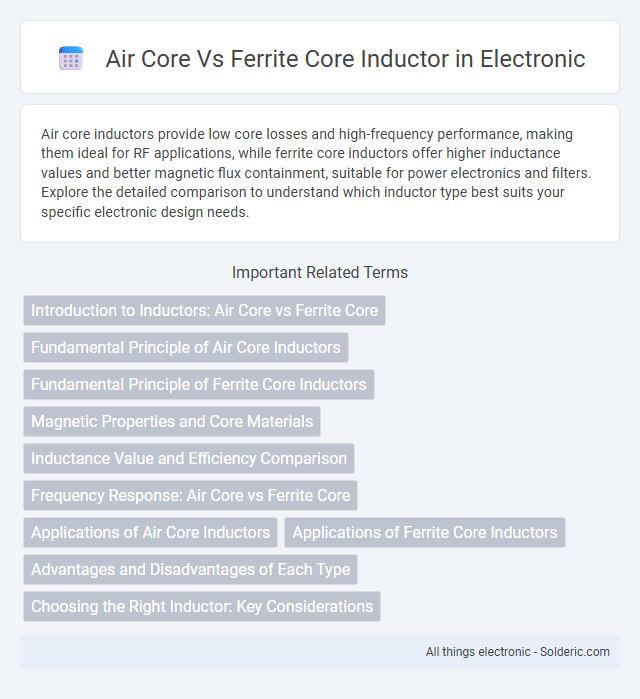Air core inductors provide low core losses and high-frequency performance, making them ideal for RF applications, while ferrite core inductors offer higher inductance values and better magnetic flux containment, suitable for power electronics and filters. Explore the detailed comparison to understand which inductor type best suits your specific electronic design needs.
Comparison Table
| Feature | Air Core Inductor | Ferrite Core Inductor |
|---|---|---|
| Core Material | Air (non-magnetic) | Ferrite (magnetic) |
| Inductance Range | Low to medium (mH to mH) | High (mH to several H) |
| Frequency Performance | Excellent at high frequencies (MHz range) | Optimal for low to medium frequencies (kHz to low MHz) |
| Core Losses | Minimal core losses (no magnetic core) | Higher core losses due to hysteresis and eddy currents |
| Size | Larger size for same inductance | Smaller size due to high permeability |
| Linearity | Highly linear inductance | Non-linear, may saturate under high current |
| Applications | High-frequency filters, radio transmitters, RF circuits | Power supplies, transformers, audio equipment, EMI suppression |
| Cost | Generally lower cost | Higher cost due to magnetic material |
| Temperature Stability | Stable over temperature | May vary with temperature due to magnetic properties |
Introduction to Inductors: Air Core vs Ferrite Core
Air core inductors use a non-magnetic core made of air, offering low inductance and minimal core losses, ideal for high-frequency applications. Ferrite core inductors contain a magnetic ferrite material that increases inductance and energy storage, making them suitable for power and signal filtering in lower frequency ranges. Your choice depends on the application's frequency, inductance requirements, and efficiency considerations.
Fundamental Principle of Air Core Inductors
Air core inductors operate on the fundamental principle of generating magnetic fields without the use of a ferromagnetic core, relying solely on the coil's geometry and current flow to produce inductance. Their absence of a magnetic core eliminates core losses and non-linearity, making them ideal for high-frequency applications where signal purity and minimal distortion matter. Your choice of air core inductors ensures stable inductance values and reduced electromagnetic interference in RF circuits and high-speed digital devices.
Fundamental Principle of Ferrite Core Inductors
Ferrite core inductors operate on the principle of magnetic permeability, where ferrite material enhances the inductance by concentrating magnetic flux within the core. This results in higher inductance values and reduced core losses compared to air core inductors, making ferrite cores ideal for high-frequency applications. The magnetic properties of ferrite allow for compact inductor designs with improved efficiency and minimized electromagnetic interference.
Magnetic Properties and Core Materials
Air core inductors use non-magnetic materials, resulting in low inductance but excellent high-frequency performance due to negligible core losses and no magnetic saturation. Ferrite core inductors utilize ferrite ceramics with high magnetic permeability, enhancing inductance and energy storage while reducing core losses at high frequencies. The choice between air core and ferrite core inductors depends on the required inductance, frequency range, and magnetic saturation tolerance inherent in the core materials.
Inductance Value and Efficiency Comparison
Air core inductors provide high-frequency performance with minimal core losses, making them highly efficient but typically offering lower inductance values compared to ferrite core inductors. Ferrite core inductors achieve higher inductance values due to the magnetic properties of the ferrite material but experience increased core losses at high frequencies, which can reduce efficiency. Your choice depends on balancing the need for higher inductance with the desired efficiency in your application.
Frequency Response: Air Core vs Ferrite Core
Air core inductors offer superior high-frequency response due to the absence of core losses and magnetic saturation, making them ideal for RF and high-frequency applications. Ferrite core inductors provide higher inductance values with smaller size but exhibit increased core losses and non-linear behavior at higher frequencies, limiting their effectiveness above several MHz. Selecting between air core and ferrite core inductors depends critically on balancing frequency response requirements against size and inductance needs.
Applications of Air Core Inductors
Air core inductors are ideal for high-frequency applications due to their low core losses and minimal magnetic interference, making them suitable for RF circuits, antennas, and signal processing. Their non-magnetic core ensures linear inductance and prevents core saturation, which is crucial in tuning circuits and precision filters. You'll find air core inductors commonly used in wireless communication devices, oscillators, and audio equipment where signal integrity is paramount.
Applications of Ferrite Core Inductors
Ferrite core inductors are widely used in high-frequency applications such as power supplies, RF circuits, and signal filtering due to their high magnetic permeability and low eddy current losses. Their ability to handle higher inductance values in a compact size makes them ideal for switching power regulators, noise suppression in electronic devices, and wireless communication systems. You can rely on ferrite core inductors for efficient energy storage and effective electromagnetic interference reduction in various electronic applications.
Advantages and Disadvantages of Each Type
Air core inductors offer low core losses and high linearity, making them ideal for high-frequency applications where signal integrity is crucial, but they tend to have lower inductance values and larger physical sizes compared to ferrite core inductors. Ferrite core inductors provide higher inductance and compact size due to their high magnetic permeability, which improves energy storage efficiency, but they exhibit core losses and non-linear behavior at high frequencies. You should choose air core inductors for precision RF circuits and ferrite cores for power applications requiring compact inductors with higher inductance.
Choosing the Right Inductor: Key Considerations
Choosing the right inductor involves evaluating factors such as frequency range, magnetic properties, and power handling, where air core inductors excel at high frequencies due to minimal core loss and saturation. Ferrite core inductors offer higher inductance values and better magnetic coupling, making them suitable for lower frequency applications requiring compact size and efficient energy storage. Your choice depends on balancing size constraints, efficiency, and operating frequency to optimize circuit performance.
Air core vs Ferrite core inductor Infographic

 solderic.com
solderic.com